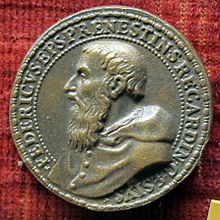|
Federico Cesi (cardinal)
 Federico Cesi (2 July 1500 — 28 January 1565) was an Italian Roman Catholic bishop and cardinal. BiographyFederico Cesi was born in Rome on 2 July 1500, the son of Roman noble Angelo Cesi of the House of Cesi and his wife Francesca Cardoli.[1] He was the younger brother of Cardinal Paolo Emilio Cesi.[1] He studied law at the University of Rome and then practiced law in Rome.[1] He later left legal practice to become a priest.[1] On 12 June 1523, he was elected Bishop of Todi, with dispensation for not having reached the canonical age.[1] He was consecrated as a bishop in Rome on 25 July 1524 by Paris de Grassis, Bishop of Pesaro.[1] He soon became a member of the Apostolic Camera.[1] Pope Paul III made him a cardinal priest in the consistory of 19 December 1544.[1] He received the red hat and the titular church of San Pancrazio on 9 July 1545.[1] He resigned the government of the Diocese of Todi on 11 March 1545.[1] From 9 November 1549 to 12 February 1552 he was the administrator of the Diocese of Caserta.[1] He participated in the papal conclave of 1549-50 that elected Pope Julius III.[1] He opted for the titular church of Santa Prisca on 28 February 1550.[1] From 15 July 1550 to 14 March 1551 he was the administrator of the Diocese of Vulturaria e Montecorvino.[1] He then administered the Diocese of Cremona from 18 March 1551 until 13 March 1560.[1] He also served as Camerlengo of the Sacred College of Cardinals from 7 January 1555 to 10 January 1556.[1] He was a participant in both the papal conclave of April 1555 that elected Pope Marcellus II and the papal conclave of May 1555 that elected Pope Paul IV.[1] On 20 September 1557 he opted for the order of cardinal bishops, receiving the suburbicarian see of Palestrina.[1] He then participated in the papal conclave of 1559 that elected Pope Pius IV.[1] He opted for the suburbicarian see of Frascati on 18 May 1562, and then for the suburbicarian see of Porto e Santa Rufina on 12 May 1564.[1] During this period he was Vice-Dean of the College of Cardinals.[1]  Cardinal Cesi was friends with Charles Borromeo, Ignatius of Loyola, and Philip Neri.[1] He created one of the most famous gardens in early modern Rome near St. Peter's Basilica. There he exhibited his collection of antiques, a sculpture garden, which is depicted in a painting by Hendrick van Cleve III.[2] In 1622 the collection, which included the famous Juno Ludovisi, was acquired by Cardinal Ludovico Ludovisi. Cardinal Cesi died in Rome on 28 January 1565.[1] Following a funeral at Santa Caterina dei Funari, he was buried in the Basilica di Santa Maria Maggiore.[1] References |